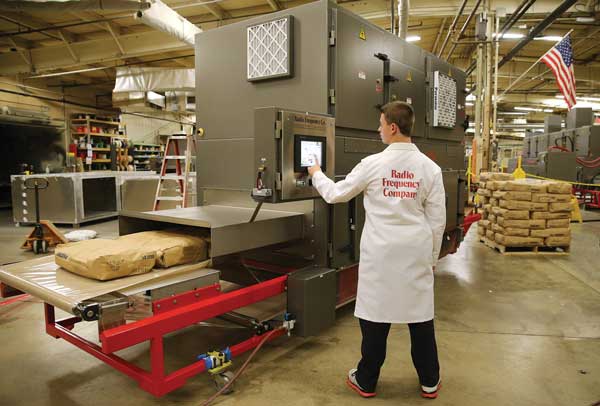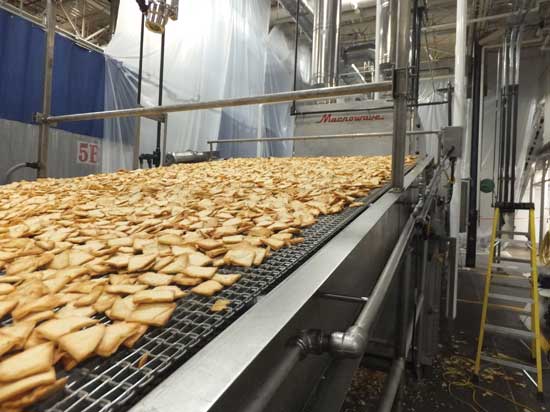Radio Frequency Processing of Food
PROCESSING
Radio frequency (RF) heating is a commonly used food processing technology that has been applied for drying and baking as well as thawing of frozen foods. Its use in pasteurization, as well as for sterilization and disinfection of foods, is more limited. This column will review various RF heating applications in food processing, as well as the basic principles of this technology.
 The Basic Science
The Basic Science
RF processing uses dielectric heating to thermally process foods using electromagnetic waves. RF wavelengths cover the range of the electromagnetic spectrum from 3 kHz to 300 MHz. Only frequencies of 13.56 MHz, 27.12 MHz, and 40.68 MHz are permitted for use in the United States. During RF processing, dielectric materials are placed in an alternating electric field. RF energy is generated by a triode valve and applied to the food via a pair of electrodes. Dielectric heat energy is generated in the food by molecular friction as high-frequency electric fields alternate. Unlike conventional heating, dielectric heating is fast and volumetric.
RF processing can be used to process any dielectric material and most food products are dielectric. Foods contain polar molecules such as water, and these molecules have dipole moments, positive and negative charge centers that do not coincide. When placed in an electric field, polar molecules align with the field via the dipole moment phenomenon. In this way, polar molecules rotate continuously to align with the field as the field is alternated. Friction is created between the molecules, converting electromagnetic energy into heat and increasing the temperature of the food. Dissociative ions in foods also produce heat through ionic conduction whereby the ions oscillate forward and backward in the food creating friction and heat.
The electromagnetic characteristics of the food are important in determining process parameters. The two important properties are permeability and permittivity. Permeability has a very small contribution to dielectric heating and is therefore not usually considered. Permittivity is the parameter most commonly used to describe the dielectric properties of foods. It relates the reflection of electromagnetic waves at interfaces and the attenuation of the wave energy within the food. Dielectric properties of many foods have been studied by researchers and can be found in the literature. The three most popular methods to measure dielectric properties are transmission line, open-ended coaxial probe, and the resonant cavity method. It is important to remember that dielectric properties are dependent on temperature and frequency as well as the density, structure, composition, and moisture content of the food.
Radio Frequency Versus Microwave
RF heating has several advantages over microwave heating. RF heating is simpler than microwave heating in that it generates an electrical field between a pair of electrodes in one direction in contrast with microwave heating, which transmits in all directions. Microwave equipment also requires a waveguide to transmit microwaves. In these ways, construction of large RF heating systems is simpler and its application to continuous processes more straightforward. Another difference is that RF processing uses lower frequencies than microwave, resulting in longer penetration depths that make it useful to process bulk food materials that have larger dimensions. RF processing also has the ability to dynamically control final product moisture content. Oscillator circuits can be dynamically matched to load automatically, controlling the power absorbed by the load. In this way, RF driers can automatically draw more power if the moisture in the product is too high. Finally, RF heating provides more uniform field distributions than microwave heating and as a result is slightly more efficient.
Equipment Design
There are two design types of RF heating equipment. They are the free-running traditional oscillator system and the Crystal Oscillator Source Matched Impedance Generator (COSMIG) 50 ohm system. Traditional oscillator-based RF systems are simple to use and lower in cost than newer COSMIG 50 ohm systems. The newer systems, although more costly, allow for precise frequency and power control with feedback on forward and reflected power, thus enabling precise control of processing parameters such as power and heating rate to obtain exact final product properties such as moisture content.
Parallel plate “through-field” RF systems are the most commonly used in the industry; however, there are two other configuration types. “Fringe-field” and “staggered through-field” systems, which contain rod- or tube-shaped electrodes, can be used to treat thin or intermediate thickness products.
Several companies manufacture RF processing equipment for the food industry. A few of the leaders are Radio Frequency Co., Millis, Mass.; Stalam Co., Nove, Italy; and Strayfield Co., Theale, Berkshire, United Kingdom.
--- PAGE BREAK ---
Commercial Applications
 • Drying and Baking. Post-baking RF drying is common in cookie, cracker, cereal, and snack food manufacturing. Surface cracking often occurs during traditional drying processes due to moisture gradients in the product. RF drying solves this issue because the energy penetrates evenly, minimizing moisture gradients. The use of RF also avoids discoloration and flavor damage due to thermal buildup. It enables faster line speeds, more consistent moisture levels, lower drying temperatures, and smaller equipment footprints. In addition, RF is highly energy efficient for removing final moisture from dry baked products.
• Drying and Baking. Post-baking RF drying is common in cookie, cracker, cereal, and snack food manufacturing. Surface cracking often occurs during traditional drying processes due to moisture gradients in the product. RF drying solves this issue because the energy penetrates evenly, minimizing moisture gradients. The use of RF also avoids discoloration and flavor damage due to thermal buildup. It enables faster line speeds, more consistent moisture levels, lower drying temperatures, and smaller equipment footprints. In addition, RF is highly energy efficient for removing final moisture from dry baked products.
Traditional baking is carried out in forced-air convection ovens where the heat is transferred to the surface of the dough by convection, conduction, and irradiation, and then from the surface toward the inside by heat conduction. The dough has low heat conductivity; therefore, the traditional baking process is slow and can require as long as 30 min. In RF processing of bread, dough pieces are placed inside pans made of heat-resistant, RF compatible, food-grade polymers and introduced into the RF baking oven with controlled-temperature air flow and exhaust fans to evacuate excess moisture released during the baking process. Total baking times are reduced to 8–10 min for commercial bread loaves, and the bread does develop a crust when it comes out of the RF oven. Other techniques, such as infrared, can be used to form crusts if desired. In breads, RF processing has also been shown to reduce mold growth and staling during storage.
• Defrosting. Traditional defrosting methods suffer from intrinsically slow heat transfer. The larger the size of product, the longer the time needed. This provides opportunities for bacteria to grow, results in high drip losses, and causes adverse changes in the product quality, leading to significant economic loss.
RF rapidly generates heat volumetrically, and defrosting is achieved in minutes rather than hours/days, even for large product blocks. It can also be performed directly inside packaging. The heating process results in a significant reduction of drip losses while minimizing product deterioration due to bacterial growth, making it ideal for many defrosting processes.
• Sterilization and Pasteurization. Sterilization processes like retorting are generally carried out by treating products with drastic heat treatments, resulting in loss of product quality. Pasteurization is a relatively gentle heat treatment carried out at temperatures below the boiling point of water. Both traditional sterilization and pasteurization methods use saturated steam or pressurized hot water to heat the packaged food. The temperature rise of the product is slow and nonuniform, frequently resulting in overheating of the outside layers of the food, which results in quality losses. The ability of RF to rapidly generate heat volumetrically within the product minimizes product deterioration. The RF equipment requires less space compared to other machines based on conventional heating technology that have long heating times and require large product volumes under processing at any given time. Because no thermal energy is wasted into the environment, the RF process is more efficient, economic, and environmentally friendly. RF pasteurization is used in meat processing. Liquid pasteurization applications are also being explored.
One of the most prevalent applications for RF pasteurization is in the treatment of dry ingredients. In a dry state (5% and 15% moisture content) microbes are considered “dormant” and are difficult to kill. RF is very effective with dry ingredients like flour, cereal grains, protein supplements, spices, seeds, and pet foods, insuring their food safety. This is particularly important for ingredients that are added to foods after the cooking “kill step,” such as cookie dough inclusions for ice creams and cold-pressed health bars.
• Disinfestation. Insect infestation is another major problem. Chemical fumigants (like methyl bromide) are commonly used for postharvest pest control, but they have environmental concerns and regulatory issues. Alternative thermal treatments frequently result in product quality deterioration. RF processing allows for rapid and uniform heating of many substrates. Recent research has confirmed the viability of RF for disinfestation of fruits and nuts.
RF and the Future
Continued expansion of applications of RF processing of foods is anticipated during the years ahead. Ongoing research on dielectric properties of foods (including heterogeneous foods), final RF-treated food quality and safety, and advances in mathematical modeling all support increased implementation of RF technology and additional FDA approvals of RF processing for specific food applications like sterilization. Challenges related to avoiding dielectric breakdown (arching) and thermal runaway heating from hot spots are being addressed by researchers and equipment manufacturers. And specific new packaging materials tailored for RF processing continue to be developed. RF processing of foods has a very bright future.
 Tara McHugh, PhD, Contributing Editor
Tara McHugh, PhD, Contributing Editor
Research Leader, USDA Agricultural Research Service, Albany, Calif.
[email protected]
References
Awuah, G. B., H. S. Ramaswamy, and J. Tang. 2014. Radio Frequency Heating in Food Processing: Principles and Applications. Boca Raton: CRC Press.


